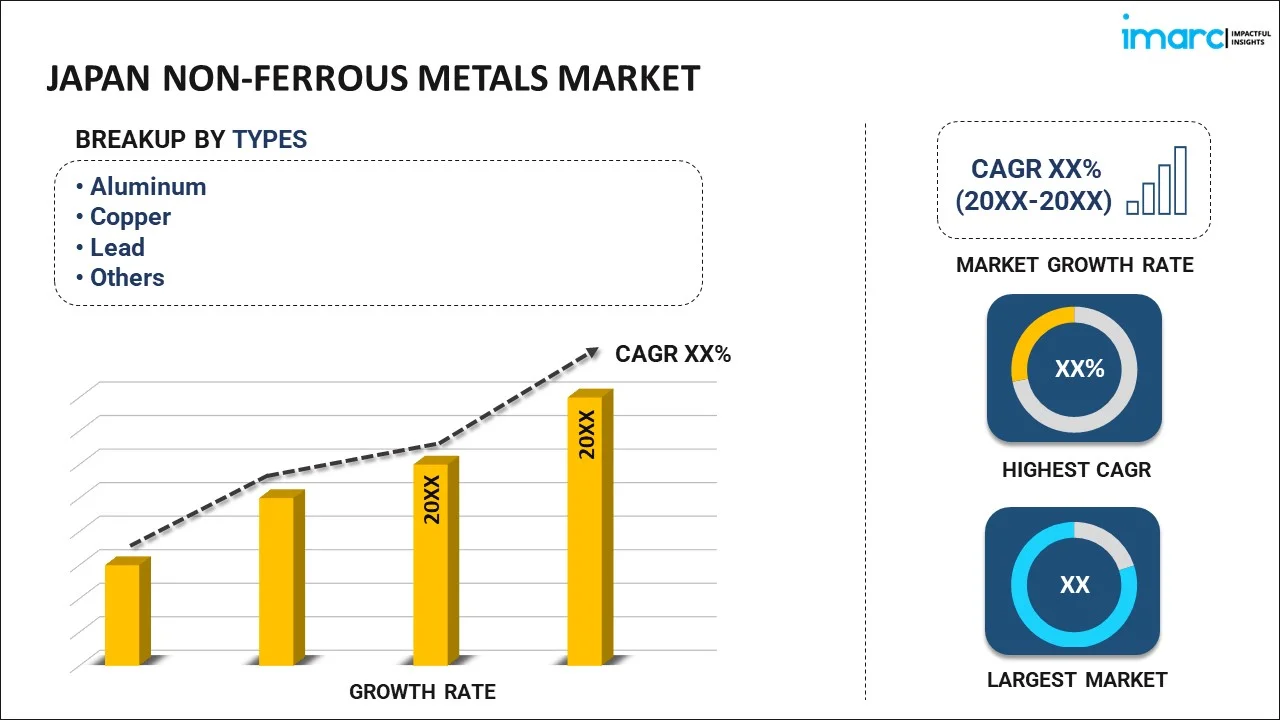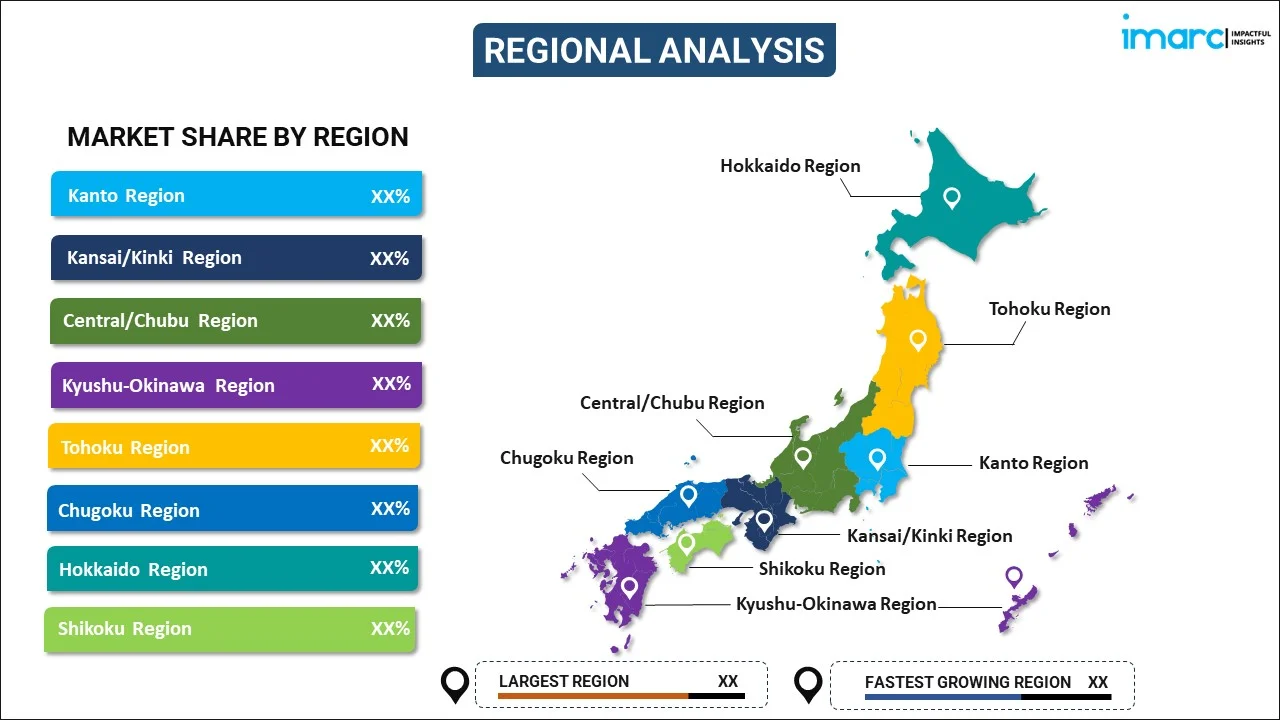
Japan Non-Ferrous Metals Market Report by Type (Aluminum, Copper, Lead, Tin, Nickel, Titanium, Zinc, and Others), Application (Automobile Industry, Electronic Power Industry, Construction Industry, and Others), and Region 2025-2033
Market Overview:
Japan non-ferrous metals market size reached USD 38.1 Billion in 2024. Looking forward, IMARC Group expects the market to reach USD 59.7 Billion by 2033, exhibiting a growth rate (CAGR) of 4.6% during 2025-2033. The increasing demand from the manufacturing sector, technological innovation in electronics and renewable energy, thriving construction industry, emphasis on sustainability and recycling, and rise of electric vehicles (EVs) represent some of the key factors driving the market.
|
Report Attribute
|
Key Statistics
|
|---|---|
|
Base Year
|
2024
|
|
Forecast Years
|
2025-2033
|
|
Historical Years
|
2019-2024
|
| Market Size in 2024 | USD 38.1 Billion |
| Market Forecast in 2033 | USD 59.7 Billion |
| Market Growth Rate 2025-2033 | 4.6% |
Non-ferrous metals are metals that do not contain iron and, consequently, lack magnetic properties. This category includes a diverse range of elements and alloys, with some of the most common being aluminum, copper, lead, zinc, nickel, and precious metals like gold and silver. Compared to ferrous metals, which contain iron and are susceptible to rust, non-ferrous metals exhibit corrosion resistance, making them valuable for various applications. These metals find extensive use in industries such as construction, automotive manufacturing, electronics, and aerospace due to their desirable properties, such as lightweight nature, high conductivity (in the case of copper and aluminum), and resistance to corrosion. Moreover, non-ferrous metals are crucial components in the production of everyday items like wiring, pipes, coins, and jewelry. The recyclability of non-ferrous metals further contributes to their importance, aligning with global efforts toward sustainable resource management and reducing environmental impact. The versatility and advantageous characteristics of non-ferrous metals make them indispensable in modern industrial processes and play a vital role in shaping technological advancements and sustainable practices.
Japan Non-Ferrous Metals Market Trends:
The thriving manufacturing sector in Japan, ranging from automotive to electronics, relies heavily on non-ferrous metals such as aluminum and copper, which is primarily driving the market growth. Besides this, the country's dedication to technological innovation, especially in the electronics and renewable energy sectors, has led to increased consumption of non-ferrous metals for the production of advanced components and devices, creating a positive outlook for the market expansion. Moreover, the construction industry's robust performance has contributed significantly to the demand for non-ferrous metals in applications like wiring, piping, and structural components, thereby strengthening the market growth. In confluence with this, Japan's commitment to sustainability and environmental responsibility has accentuated the importance of recycling non-ferrous metals, aiding in market expansion. Concurrently, the global trend towards electric vehicles (EVs) has driven a surge in demand for non-ferrous metals like lithium, nickel, and cobalt, essential components in the manufacturing of batteries, thereby providing an impetus to the market growth. In addition to this, the country's efforts to reduce carbon emissions and promote green technologies have stimulated growth in the renewable energy sector, subsequently fueling the demand for non-ferrous metals for solar panels and wind turbines. Furthermore, Japan's status as a significant player in the global precious metals market, including gold and silver, has been buoyed by their applications in jewelry, electronics, and investment, which, in turn, is contributing to the market's expansion. Apart from this, the expanding infrastructure development spurring the demand for non-ferrous metals, as they are essential in the construction of bridges, airports, and other critical structures, is presenting lucrative opportunities for the market growth.
Japan Non-Ferrous Metals Market Segmentation:
IMARC Group provides an analysis of the key trends in each segment of the market, along with forecasts at the country level for 2025-2033. Our report has categorized the market based on type and application.
Type Insights:

- Aluminum
- Copper
- Lead
- Tin
- Nickel
- Titanium
- Zinc
- Others
The report has provided a detailed breakup and analysis of the market based on the type. This includes aluminum, copper, lead, tin, nickel, titanium, zinc, and others.
Application Insights:
- Automobile Industry
- Electronic Power Industry
- Construction Industry
- Others
A detailed breakup and analysis of the market based on the application have also been provided in the report. This includes automobile industry, electronic power industry, construction industry, and others.
Regional Insights:

- Kanto Region
- Kansai/Kinki Region
- Central/ Chubu Region
- Kyushu-Okinawa Region
- Tohoku Region
- Chugoku Region
- Hokkaido Region
- Shikoku Region
The report has also provided a comprehensive analysis of all the major regional markets, which include Kanto Region, Kansai/Kinki Region, Central/ Chubu Region, Kyushu-Okinawa Region, Tohoku Region, Chugoku Region, Hokkaido Region, and Shikoku Region.
Competitive Landscape:
The market research report has also provided a comprehensive analysis of the competitive landscape. Competitive analysis such as market structure, key player positioning, top winning strategies, competitive dashboard, and company evaluation quadrant has been covered in the report. Also, detailed profiles of all major companies have been provided. Some of the key players include:
- Alconix Corporation
- ITOCHU Corporation
- Rio Tinto
- Sadoshima Co. Ltd.
- Sumitomo Metal Mining Co. Ltd.
(Please note that this is only a partial list of the key players, and the complete list is provided in the report.)
Japan Non-Ferrous Metals Market Report Coverage:
| Report Features | Details |
|---|---|
| Base Year of the Analysis | 2024 |
| Historical Period | 2019-2024 |
| Forecast Period | 2025-2033 |
| Units | Billion USD |
| Scope of the Report | Exploration of Historical Trends and Market Outlook, Industry Catalysts and Challenges, Segment-Wise Historical and Future Market Assessment:
|
| Types Covered | Aluminum, Copper, Lead, Tin, Nickel, Titanium, Zinc, Others |
| Applications Covered | Automobile Industry, Electronic Power Industry, Construction Industry, Others |
| Regions Covered | Kanto Region, Kansai/Kinki Region, Central/ Chubu Region, Kyushu-Okinawa Region, Tohoku Region, Chugoku Region, Hokkaido Region, Shikoku Region |
| Companies Covered | Alconix Corporation, ITOCHU Corporation, Rio Tinto, Sadoshima Co. Ltd., Sumitomo Metal Mining Co. Ltd., etc. |
| Customization Scope | 10% Free Customization |
| Post-Sale Analyst Support | 10-12 Weeks |
| Delivery Format | PDF and Excel through Email (We can also provide the editable version of the report in PPT/Word format on special request) |
Key Questions Answered in This Report:
- How has the Japan non-ferrous metals market performed so far and how will it perform in the coming years?
- What has been the impact of COVID-19 on the Japan non-ferrous metals market?
- What is the breakup of the Japan non-ferrous metals market on the basis of type?
- What is the breakup of the Japan non-ferrous metals market on the basis of application?
- What are the various stages in the value chain of the Japan non-ferrous metals market?
- What are the key driving factors and challenges in the Japan non-ferrous metals?
- What is the structure of the Japan non-ferrous metals market and who are the key players?
- What is the degree of competition in the Japan non-ferrous metals market?
Key Benefits for Stakeholders:
- IMARC’s industry report offers a comprehensive quantitative analysis of various market segments, historical and current market trends, market forecasts, and dynamics of the Japan non-ferrous metals market from 2019-2033.
- The research report provides the latest information on the market drivers, challenges, and opportunities in the Japan non-ferrous metals market.
- Porter's five forces analysis assist stakeholders in assessing the impact of new entrants, competitive rivalry, supplier power, buyer power, and the threat of substitution. It helps stakeholders to analyze the level of competition within the Japan non-ferrous metals industry and its attractiveness.
- Competitive landscape allows stakeholders to understand their competitive environment and provides an insight into the current positions of key players in the market.
Need more help?
- Speak to our experienced analysts for insights on the current market scenarios.
- Include additional segments and countries to customize the report as per your requirement.
- Gain an unparalleled competitive advantage in your domain by understanding how to utilize the report and positively impacting your operations and revenue.
- For further assistance, please connect with our analysts.
 Inquire Before Buying
Inquire Before Buying
 Speak to an Analyst
Speak to an Analyst
 Request Brochure
Request Brochure
 Request Customization
Request Customization




.webp)




.webp)












